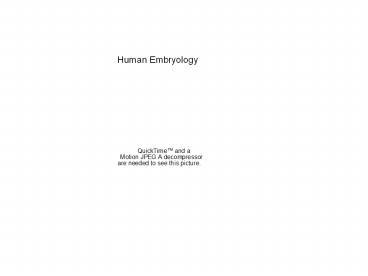Human Embryology - PowerPoint PPT Presentation
Title:
Human Embryology
Description:
Human Embryology segmentation and patterning somites Synpolydactyly can be caused by alanine repeat expansions in HoxD13 congenital abnormalities are often caused by ... – PowerPoint PPT presentation
Number of Views:269
Avg rating:3.0/5.0
Title: Human Embryology
1
Human Embryology
2
somites
segmentation and patterning
3
congenital abnormalities are often caused by
genetic mutations
Synpolydactyly can be caused by alanine repeat
expansions in HoxD13
4
fertilization to birth
5
cell fates
6
Day 6 -7 Blastocyst attaches to the endometrium
and burrows in implantation.
gastrulation formation of 3 germ layers
7
day 15-21
week 4
8
week 7-organs formed (except brain and lung)
week 9-40 brain and lung continue to develop
9
the spermatozoon cell membrane has fused with the
oocyte membrane
chromatin is enclosed within male and female
pronuclei, membranes disappear, chromosomes
replicate prior to cleavage.
fertilization-4cells
10
after fertilization, cleavage occurs as the
zygote travels down the oviduct
- mitotic divisions w/o increase in size
- zygote subdivides into blastomeres (daughter
cells) - asynchonous divisions
- 4. after about 4 days (32 cells) Morula
intercellular clefts
Compaction The embryo is transformed from a
loosely organized ball of cells into a compact
closely adherent cluster-they lose their
intercellular clefts
11
cleavage compaction
formation of the blastocyst
12
blastocyst inner cell mass trophectoderm
Trophectoderm
ICM
embryo yolk sac amnion part of placenta
extra-embryonic tissue
13
The ICM is a source of totipotent embryonic stem
(ES) cells
Gene targeting
ES cells can be used for gene targeting gene
therapy
14
24h before implantation
15
Gastrulation-why is it so important?
2-layered germ-disc is converted to a 3-layered
germ disc
cells in different layers interact to initiate
embryonic development
primitive streak
epiblast
endoderm
hypoblast
16
Gastrulation starts with formation of the
primitive streak
node
17
- The primitive streak is a thickened region at the
midline formed by cells of the epiblast - It begins to form at the posterior pole of the
embryo - The node forms at the cranial end of the embryo
- Primitive streak cells move over the primitive
pit, over the primitive ridges - and into the groove forming endoderm and
mesoderm. - The remaining cells form ectoderm
18
ECTODERMAL MOVEMENTS DURING GASTRULATION 1
origin of caudal mesoderm 2 origin of lateral
mesoderm 3 origin of notochord A and B
mesoderm is not interposed between ectoderm and
endoderm these are the future pharyngeal (A) and
cloacal (B) membranes.
pharyngeal membrane
A
2
3
1
B
cloacal membrane
19
OUR AXIS
anterior (rostral)
dorsal
ventral
posterior (caudal)
20
what does an embryo look like?
21
Ectodermal derivatives
22
Mesodermal derivatives
23
Endodermal derivatives
24
(No Transcript)
25
(No Transcript)
26
(No Transcript)
27
(No Transcript)
28
(No Transcript)
29
(No Transcript)






















![[PDF] Netter's Atlas of Human Embryology 1st Edition Kindle PowerPoint PPT Presentation](https://s3.amazonaws.com/images.powershow.com/10082437.th0.jpg?_=202407201010)



![[PDF] The Developing Human 10th Edition Android PowerPoint PPT Presentation](https://s3.amazonaws.com/images.powershow.com/10106001.th0.jpg?_=20240823069)

![[PDF] DOWNLOAD EBOOK Human Embryology and Developmental Biology PowerPoint PPT Presentation](https://s3.amazonaws.com/images.powershow.com/10130801.th0.jpg?_=20240916076)
![[PDF] DOWNLOAD FREE Human Embryology and Developmental Biology - Inkli PowerPoint PPT Presentation](https://s3.amazonaws.com/images.powershow.com/10130802.th0.jpg?_=20240916075)

